Automatic Milk Quantity Recording System for Small-Scale Dairy Farms Based on Internet of Things
Abstract
:1. Introduction
2. Related Work
3. Material and Methods
3.1. Small-Scale Dairy Farms
3.2. Bucket Milking Machine
3.3. Recording Individual Milk Quantity
3.4. Proposed Systems for Automatic Milk Quantity Recording System
3.5. Control Unit
3.5.1. Weight Mechanism
3.5.2. Embedded System
Hardware Design
- -
- The Arduino Mega 2560 PRO is utilized as the main controller. It is responsible for receiving data from the key switches to determine the cow number; collecting data from the load cell to measure milk quantity; storing the data that are the date, time, cow ID and individual and total milk quantity onto the microSD memory; sending all data to the Google Sheet platform through the Node MCU.
- -
- The load cell converts force into an electrical signal that can be measured. The electrical signal varies accordingly with force applied. In order to measure weight, a scale is built using load cells that are wired to an HX711 amplifier and an Arduino. This experiment utilizes strain gauge load cells with a maximum weight capacity of 50 kg.
- -
- The serial real-time clock (RTC) provides timekeeping features for use in a time-based system.
- -
- The I2C LCD shows the weight quantity as well as the date and time taken from the RTC.
- -
- A microSD card is used to store the information obtained from the reading of the sensor as well as the measurement time.
- -
- Node MCU is used to establish a wireless connection and transmit all data to the Google Sheet platform.
Software Designing
Overmilking Detecting
3.6. Recording System
4. Experimental Results
4.1. Weight Measuring Accuracy
4.2. Milk Quantity Measurement and Data Recording
4.3. Overmilking Test
5. Discussions
6. Conclusions
Author Contributions
Funding
Institutional Review Board Statement
Data Availability Statement
Acknowledgments
Conflicts of Interest
References
- Michie, C.; Andonovic, I.; Davison, C.; Hamilton, A.; Tachtatzis, C.; Jonsson, N.; Gilroy, M. The Internet of Things enhancing animal welfare and farm operational efficiency. J. Dairy Res. 2020, 87, 20–27. [Google Scholar] [CrossRef] [PubMed]
- Leonardi, S. Internet of Things (IoT) and Dairy Farm Automation. Doctoral Program in Animal Nutrition and Food Safety. Ph.D. Thesis, Università Degli Studi di Milano, Milan, Italy, 2013. [Google Scholar]
- Roelofs, J.B.; Van Erp-van der Kooij, E. Estrus detection tools and their applicability in cattle: Recent and perspectival situation. Anim. Reprod. 2015, 12, 498–504. [Google Scholar]
- Mottram, T. Animal board invited review: Precision livestock farming for dairy cows with a focus on oestrus detection. Animal 2016, 10, 1575–1584. [Google Scholar] [CrossRef] [PubMed] [Green Version]
- Bauman, D.E.; Mather, I.H.; Wall, R.J.; Lock, A.L. Major advances associated with the biosynthesis of milk. J. Dairy Sci. 2006, 89, 1235–1243. [Google Scholar] [CrossRef]
- German, J.B.; Dillard, C.J. Composition, structure and absorption of milk lipids: A source of energy, fat-soluble nutrients and bioactive molecules. Crit. Rev. Food Sci. Nutr. 2006, 46, 57–92. [Google Scholar] [CrossRef] [PubMed]
- Department of Livestock Development. Livestock Monthly Data. Available online: http://ict.dld.go.th/webnew/index.php/th/service-ict/report/396-report-thailand-livestock/reportservey2565/1660-2565-monthly (accessed on 10 October 2022).
- Ioan, H.; Gary, O. Chapter 5 Milk Production Records. In Animal Practical Exercises; Romania by AGROPRINT; University of Agricultural Science and Veterinary Medicine: Timisoara, Romania, 2019; Available online: https://www.researchgate.net/publication/338264640 (accessed on 10 October 2022).
- Korat Society Me. Farmchokchai. Available online: https://sites.google.com/site/koratsocietyme/naeana-canghwad/4-yeiym-chm-farm-chokhchay (accessed on 10 October 2022).
- Memon, M.H.; Kumar, W.; Memon, A.; Chowdhry, B.S.; Aamir, M.; Kumar, P. Internet of Things (IoT) enabled smart animal farm. In Proceedings of the 2016 3rd International Conference on Computing for Sustainable Global Development (INDIACom), New Delhi, India, 16–18 March 2016; pp. 2067–2072. [Google Scholar]
- Zakeri, A.; Saberi, M.; Aboutalebi, S.; Hussain, O.K.; Chang, E. Smart Farm: A System for Proactive Management of Raw Milk Quality. In Proceedings of the WSDM ’19: The Twelfth ACM International Conference on Web Search and Data Mining, Melbourne, Australia, 11–15 February 2019; pp. 1–8. [Google Scholar]
- da Rosa Righi, R.; Goldschmidt, G.; Kunst, R.; Deon, C.; da Costa, C.A. Towards combining data prediction and internet of things to manage milk production on dairy cows. Comput. Electron. Agric. 2020, 169, 105156. [Google Scholar] [CrossRef]
- Fouad, K.; Alary, V.; Dubron, A.; Bonnet, P.; Juanes, X.; Nigm, A.; Abdelghany, S. Developing a data collection application for following up the small-scale dairy farms’ performance in rural areas. Egypt. J. Anim. Prod. 2021, 2, 63–70. [Google Scholar] [CrossRef]
- Arago, N.; Robles, R.R.; Alvarez, C.; Mabale, A.; Legista, C.; Repiso, N.; Velasco, J. Smart Dairy Cattle Farming and In-Heat Detection through the Internet of Things (IoT). Int. J. Integr. Eng. 2022, 14, 157–172. [Google Scholar] [CrossRef]
- Nestor, N.D.; José, O.C.; Julio, R.G.; Alejandra, M.P.; Marcelo, J.L.; Rufiner, H.L.; Leonardo, L.G. Embedded system for real-time monitoring of foraging behavior of grazing cattle using acoustic signals. Comput. Electron. Agric. 2017, 138, 167–174. [Google Scholar]
- Hwang, J.; Jeong, H.; Yoe, H. Livestock Disease Counseling System Using Android Smartphone. Adv. Sci. Technol. Lett. 2014, 51, 353–359. [Google Scholar]
- Pimpa, A.; Eiamkanitchat, N.; Phatsara, C.; Moonmanee, T. Decision Support System for Dairy Cattle Management Using Computational Intelligence Technique. In Proceedings of the 2019 7th International Conference on Computer and Communications Management, Bangkok, Thailand, 27–29 July 2019; pp. 181–185. [Google Scholar]
- Anggraeni, W.; Muklason, A.; Ashari, A.F.; Wahyu, A.; Darminto. Developing Mobile Intelligent System for Cattle Disease Diagnosis and First Aid Action Suggestion. In Proceedings of the 2013 Seventh International Conference on Complex, Intelligent, and Software Intensive Systems, Taichung, Taiwan, 3–5 July 2013; pp. 117–121. [Google Scholar]
- Yan, W.J.; Chen, X.; Akcan, O.; Lim, J.; Yang, D. Big data analytics for empowering milk yield prediction in dairy supply chains. In Proceedings of the 2015 IEEE International Conference on Big Data (Big Data), Santa Clara, CA, USA, 29 October–1 November 2015; pp. 2132–2137. [Google Scholar]
- Gaworski, M.; Kic, P. Improvement of mobile milking parlours in small dairy farms including technical and functional aspects. In Proceedings of the 16th International Scientific Conference Engineering for Rural Development, Jelgava, Latvia, 24–26 May 2017; pp. 402–407. [Google Scholar]
- Akam, D.N.; Dodd, F.H.; Quick, A.J. Milking Machines and Equipment, Milking, Milk Production Hygiene and Udder Health; Food and Agriculture Organization of the United Nations: Rome, Italy; Available online: https://www.fao.org/3/t0218e/T0218E02.htm (accessed on 5 January 2022).
- Jeyabalan, V. Individual Cow Recording and Analysis System for Small Scale Dairy Farmers in Malaysia. Int. J. Comput. Appl. 2010, 18, 33–38. [Google Scholar] [CrossRef]
- Pietersma, D.; Lacroix, R.; Wade, K.M. A framework for the development of computerized management and control systems for use in dairy farming. J. Dairy Sci. 1998, 81, 2962–2972. [Google Scholar] [CrossRef]
- Rassmussen, M.D.; Frimer, E.S.; Decker, E.L. Reverse pressure gradients across the teat canal related to machine milking. J. Dairy Sci. 1994, 77, 984–993. [Google Scholar] [CrossRef]
- Neijenhuis, F.; Barkema, H.W.; Hogeveen, H.; Noordhuizen, J.P.T.M. Relationship between teat-end callosity and occurrence of clinical mastitis. J. Dairy Sci. 2001, 84, 2664–2672. [Google Scholar] [CrossRef]
- Berglund, I.; Pettersson, G.; Svennersten-Sjaunja, K. Automatic milking: Effects on somatic cell count and teat end-quality. Livest. Prod. Sci. 2002, 78, 115–124. [Google Scholar] [CrossRef]
- Edwards, J.P.; Jago, J.G.; Lopez-Villalobos, N. Milking efficiency for grazing dairy cows can be improved by increasing automatic cluster remover thresholds without applying premilking stimulation. J. Dairy Sci. 2013, 96, 3766–3773. [Google Scholar] [CrossRef] [Green Version]
- Silva Boloña, P.; Upton, J.; Reinemann, D.J. Effects of simulated quarter and udder teat cup removal settings on strip milk and milking duration in dairy cows. J. Dairy Sci. 2020, 103, 4446–4454. [Google Scholar] [CrossRef] [PubMed]
- Support Thaieasyelec. Load Cell with HX711 Amplifier Module. Available online: https://blog.thaieasyelec.com/how-to-use-load-cell-and-hx711-amplifier-module (accessed on 5 January 2022).
- Khatri, S.; Pokharel, K.P.; Bhandari, G.; Mishra, A.; Jha, S.K.; Ansari, S.; Shrestha, S. Performance evaluation of. portable milking machine on machine economy, milk yield, milking time, and milk constituents of Nepalese cattle. Agric. Eng. Int. CIGR J. 2021, 23, 78–90. [Google Scholar]

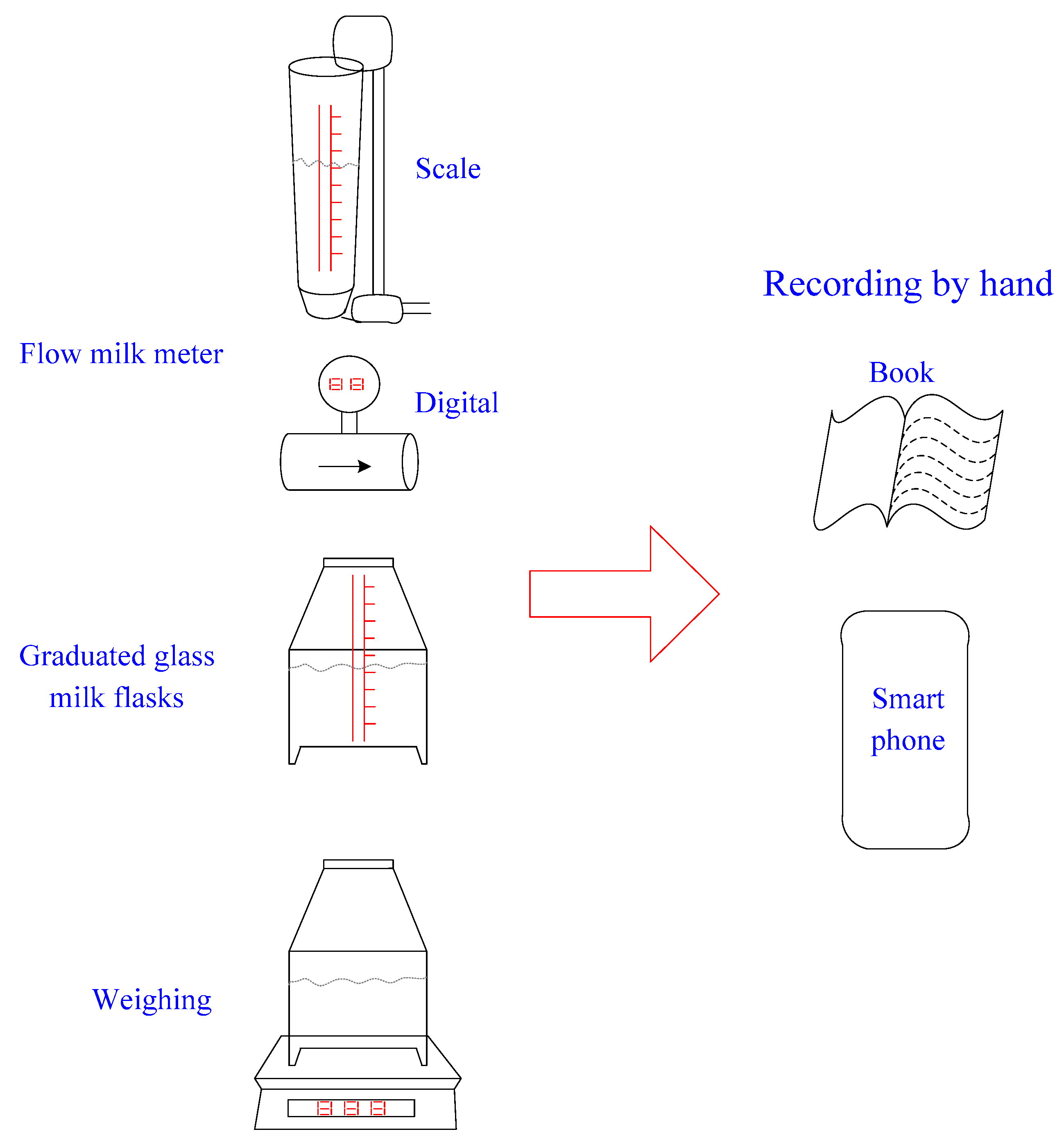
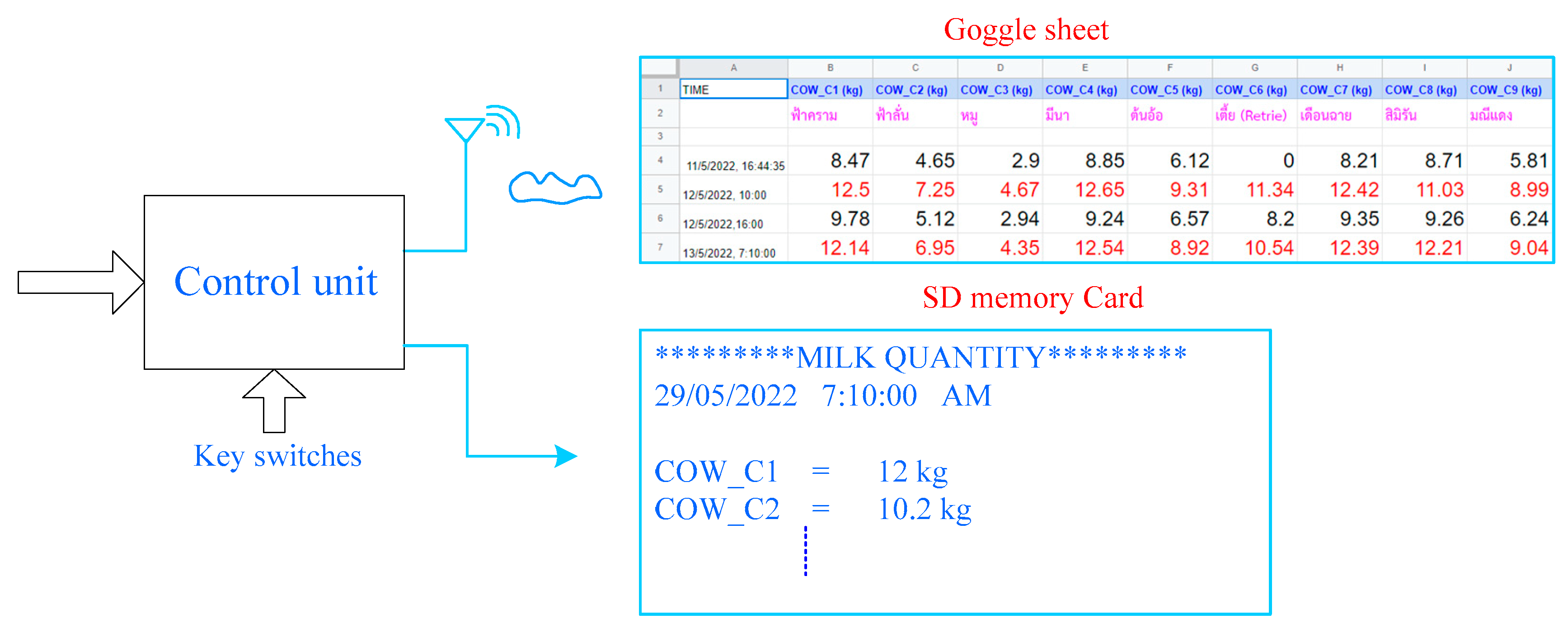
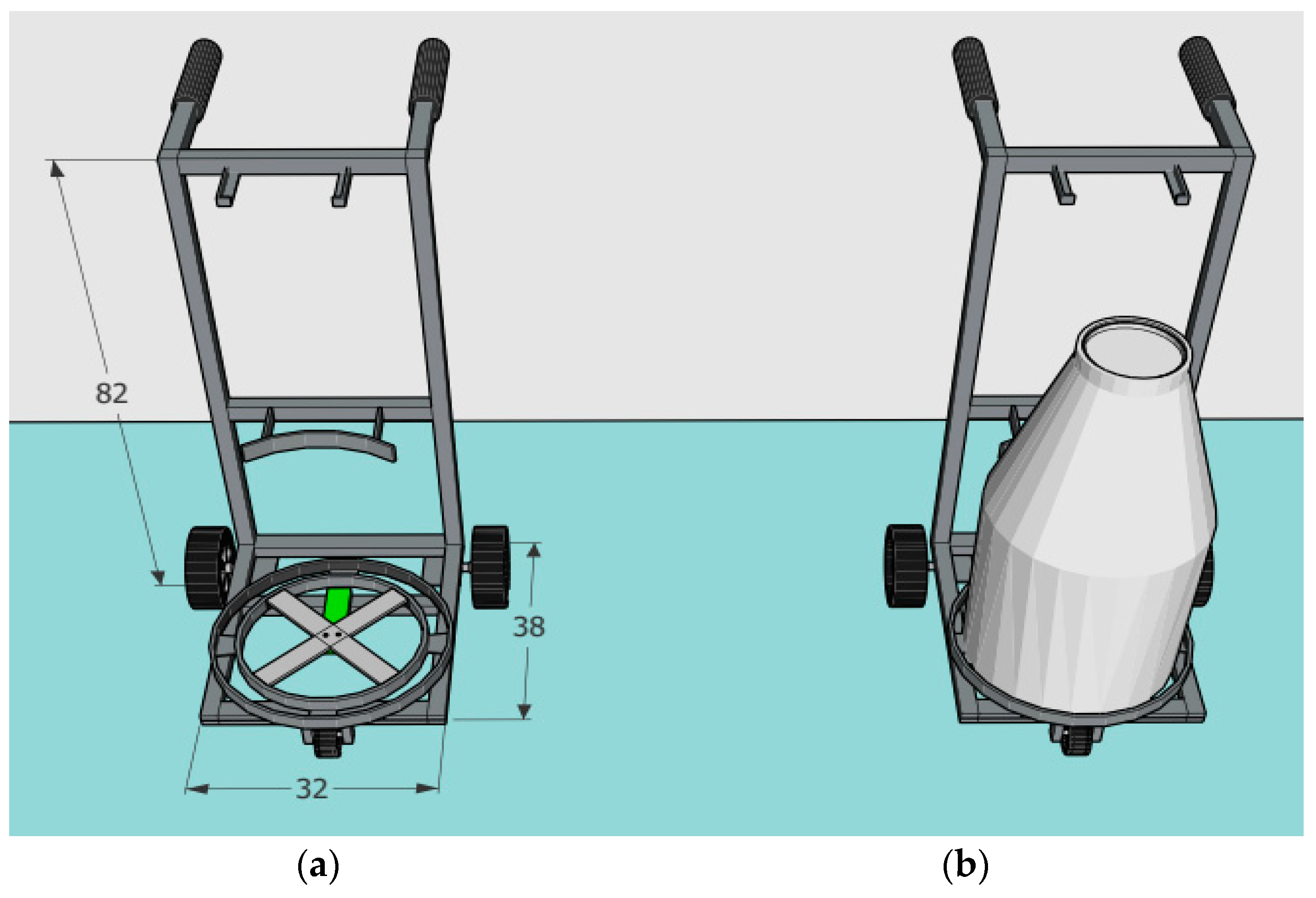
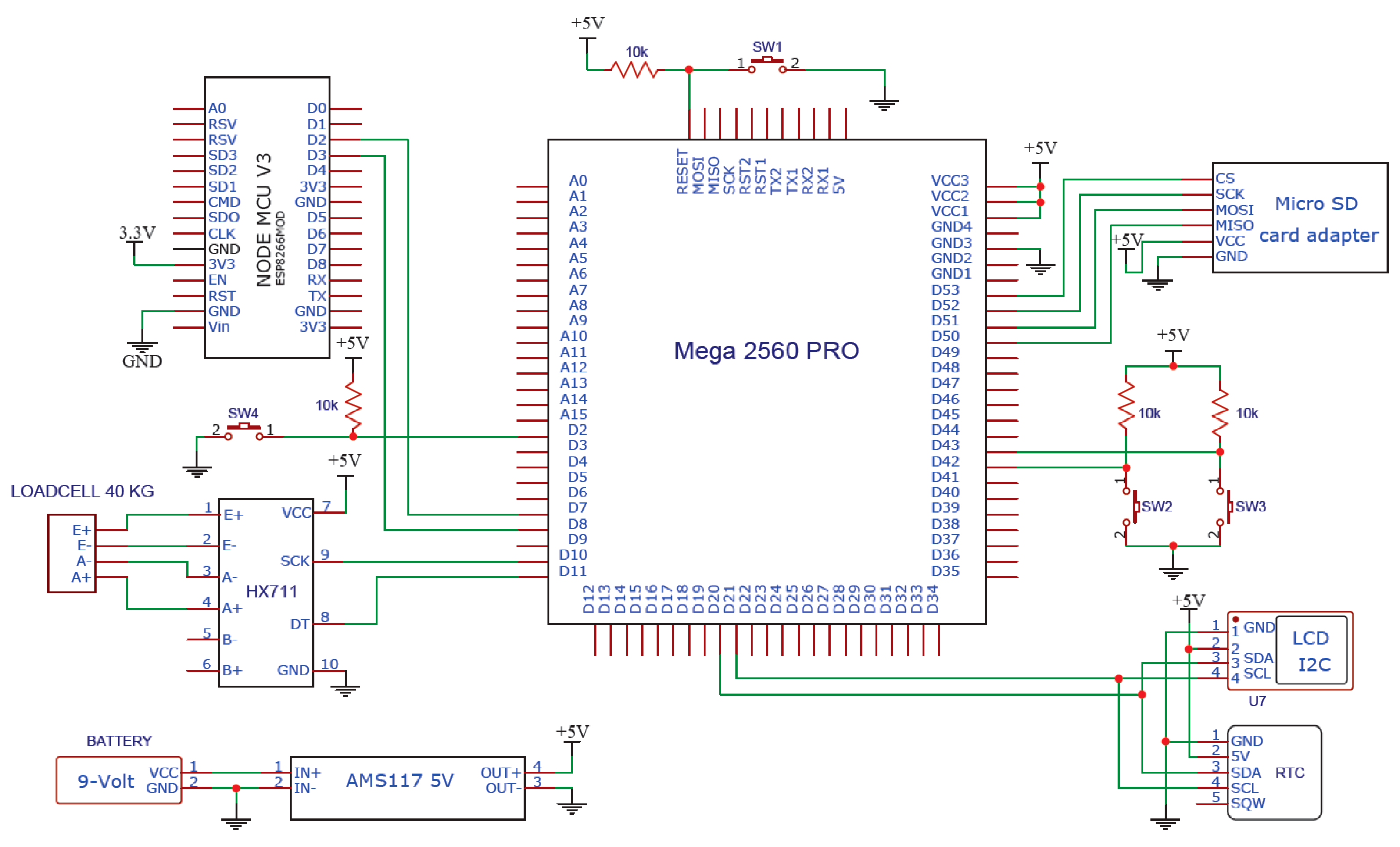
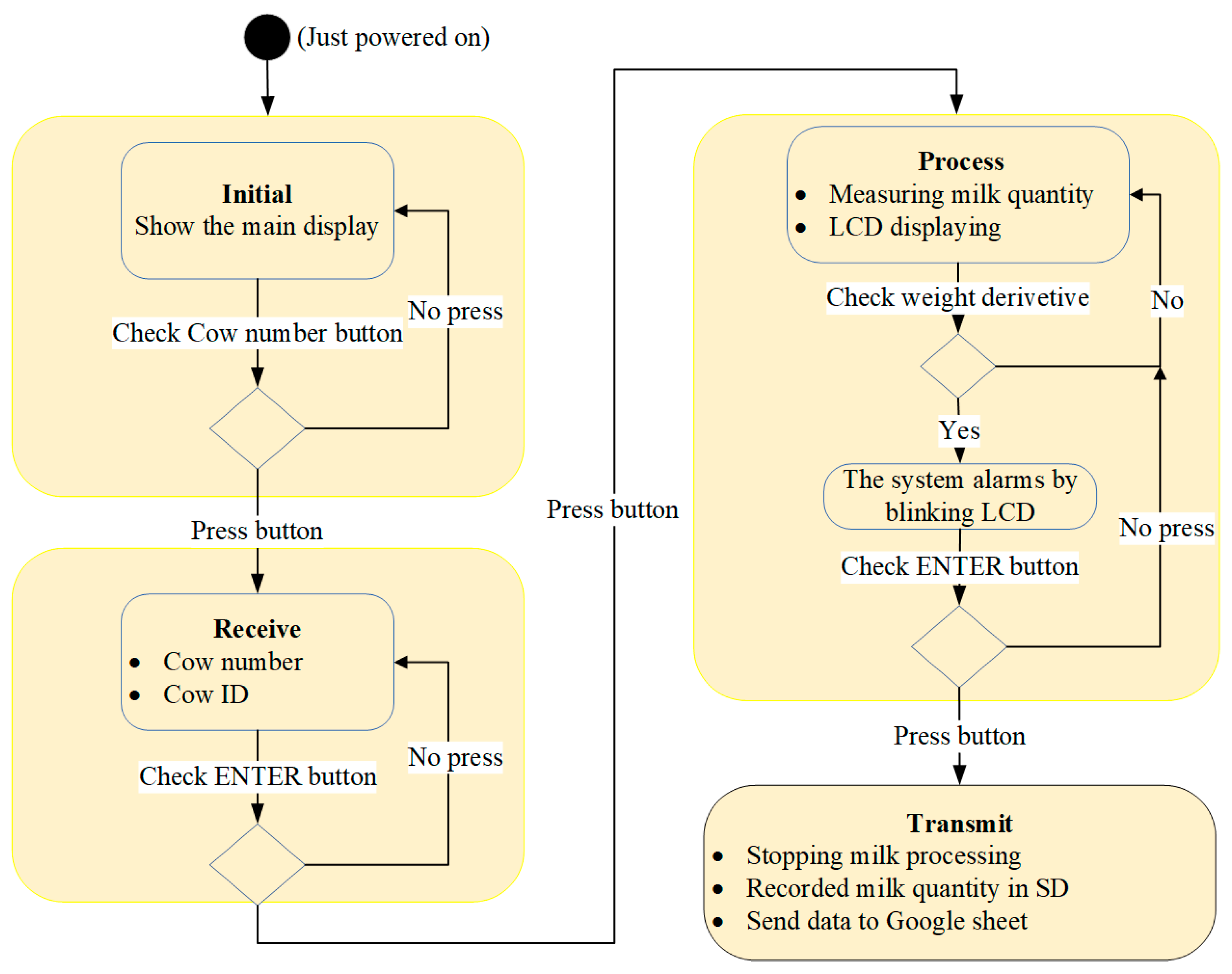
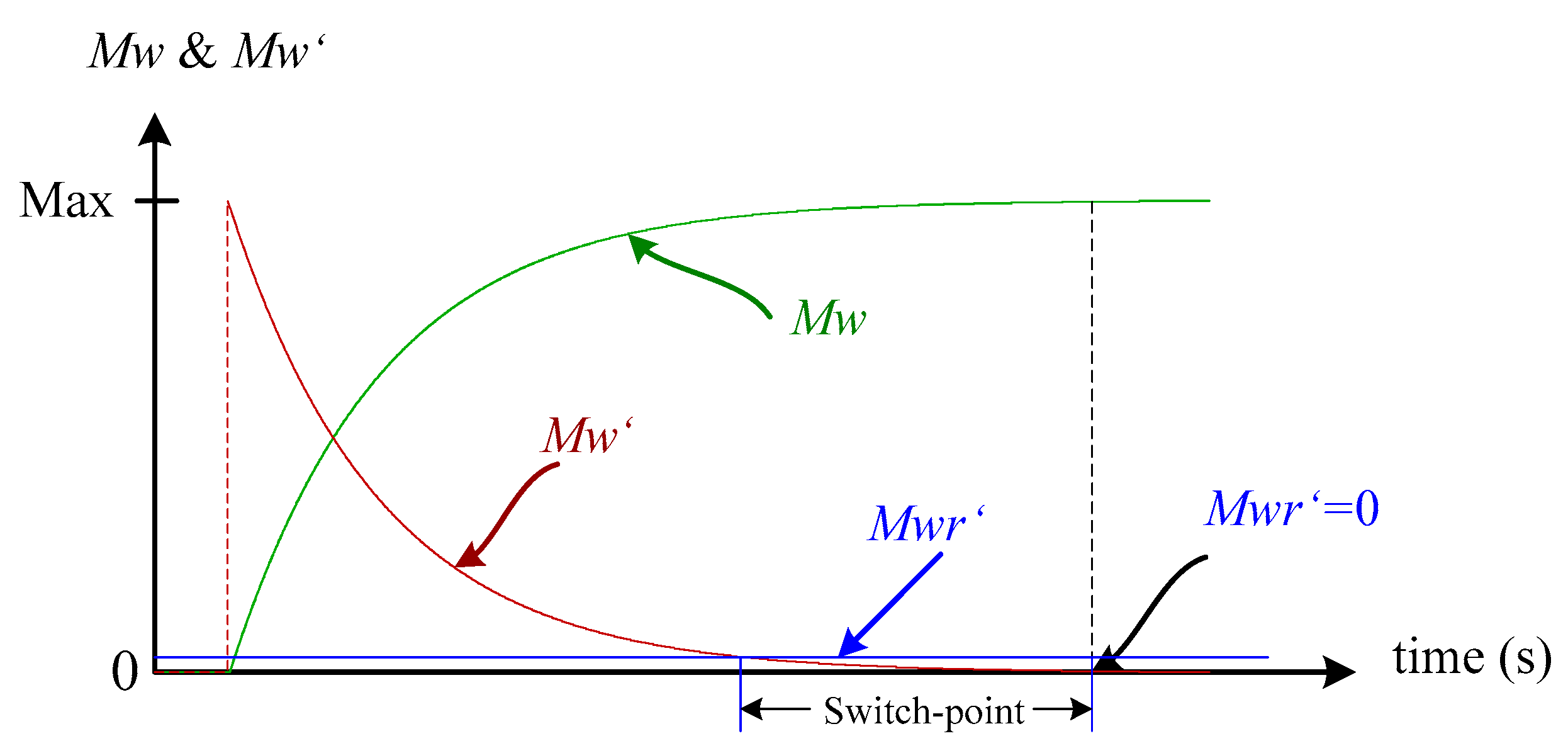
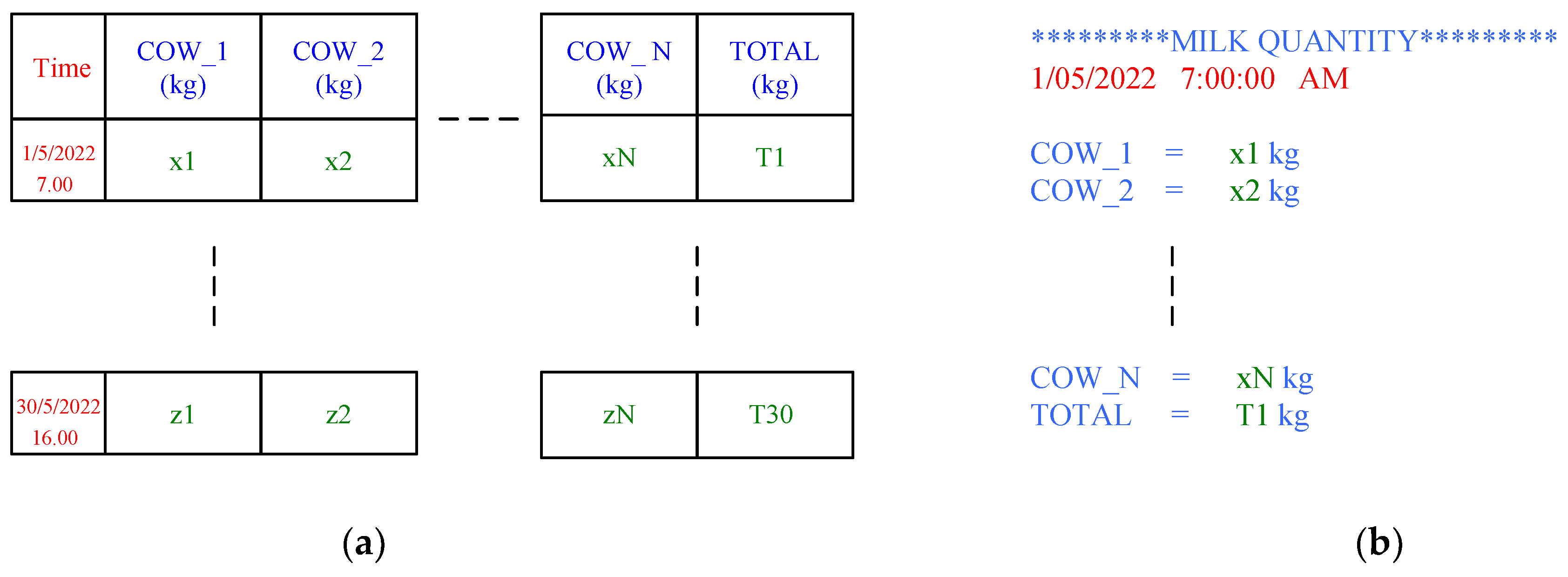


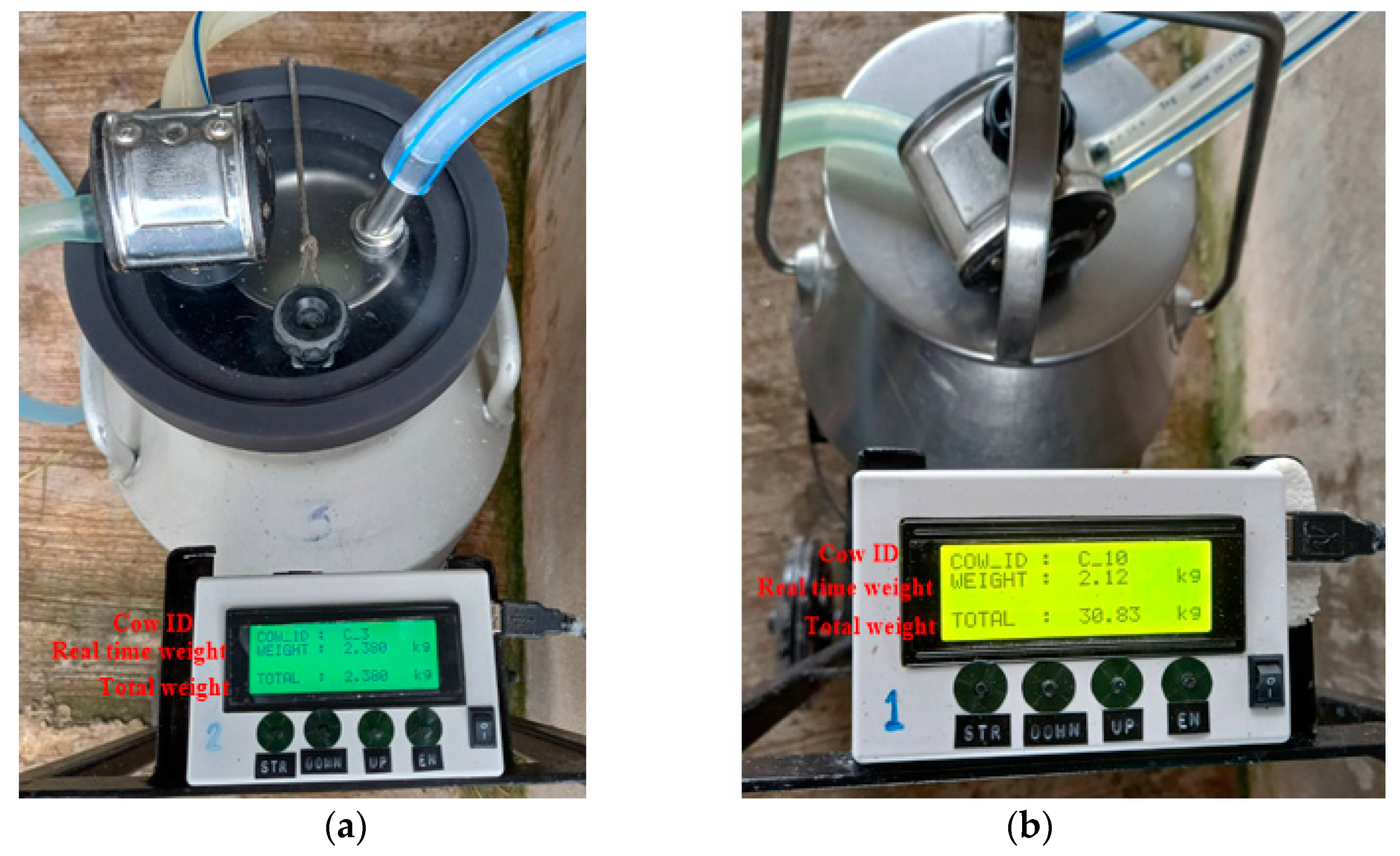
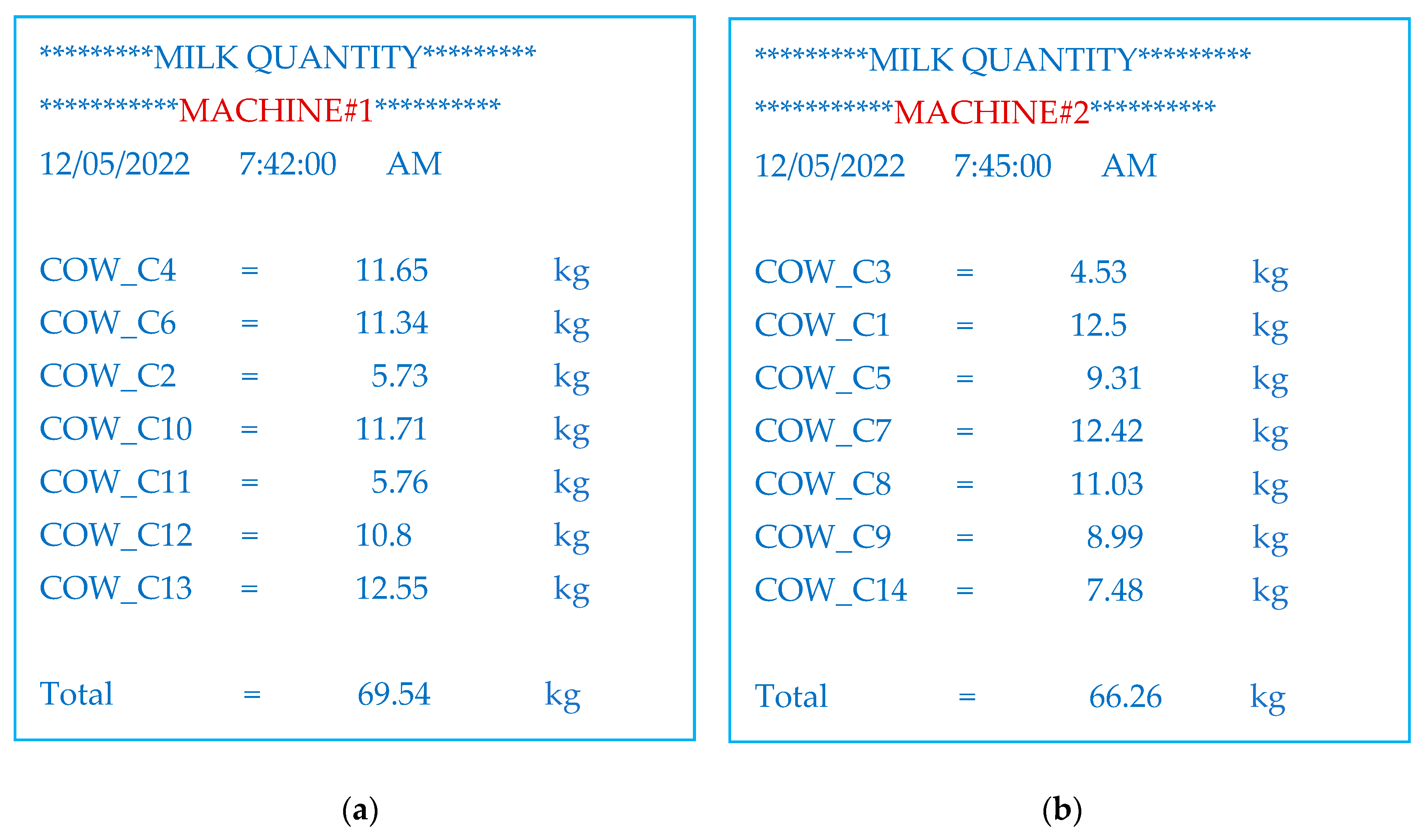


| References | Dairy Farm Scale | Data Extraction | Control and Notification System | IoT | Data Transmission | Solution |
|---|---|---|---|---|---|---|
| Memon et al. [10] | - | Sensors/automation | Fire alarm | Yes | WIFI and UDP | Control feeding, water supply, and gas depletion in farms; real-time agricultural information and recordkeeping |
| Zakeri et al. [11] | Small- and medium-sized farms | Sensors to monitor the quality of stored milk in tanks | Predictive decisions to maximize milk quality | - | Wired | System for proactive management of raw milk quality during the storage in a farm |
| Rodrigo, et al. [12] | Small-scale dairy farms | The milk sensors, RFID | Forecasting the milk production | Yes | HTTP | Combining data prediction and Internet of Things to manage milk production |
| Fouad, et al. [13] | Small-scale dairy farms | GPS | Data collected through the mobile application | Yes | Cellular | Mobile application for monitoring the productive and reproductive performance of small dairy herds. |
| Arago, et al. [14] | Small-scale commercial farms | Pan-tilt-zoom (PTZ) cameras/automation | Detects the cows and any estrus events | Yes | Long Term Evolution (LTE) | Smart Dairy Farming |
| Deniz et al. [15] | Small-and medium-sized farms | Acoustic signals | Classify three types of Events: chew, bite, and chew-bite | - | Zigbee protocol | Real-time detection and classification of events such as chew, bite, and chew-bite |
| Hwang et al. [16] | All farms | Single or multiple images of individual livestock | Diagnose livestock disease status | Yes | TCP/IP | Employing a mobile application based on Android OS to create cattle health anomaly information and transmit it to an expert for timely reaction and counseling. |
| Pimpa et al. [17] | - | Dataset of dairy cattle | Status of dairy cattle separated into 3 classes | Yes | HTTP | Dairy cattle health prediction: normal, possibly abnormal, and risk group |
| Anggraeni et al. [18] | - | Dataset of medical records | Diagnosis for three different cattle diseases | - | - | A mobile intelligent system for diagnosing cattle diseases and recommending first-aid actions. |
| Yan et al. [19] | Small-sized farms | Data of milk production | Data analytics in milk supply decision-making | - | - | The design of the tool for big data analytics can be applied in a cost-effective manner. |
| Gaworski et al. [20] | Small-sized farms | Fuel consumption | Mobile milking to calculate fuel usage. | - | - | Fuel use of the tractor that drives the mobile milking parlor |
Publisher’s Note: MDPI stays neutral with regard to jurisdictional claims in published maps and institutional affiliations. |
© 2022 by the authors. Licensee MDPI, Basel, Switzerland. This article is an open access article distributed under the terms and conditions of the Creative Commons Attribution (CC BY) license (https://creativecommons.org/licenses/by/4.0/).
Share and Cite
Kaunkid, S.; Aurasopon, A.; Chantiratiku, A. Automatic Milk Quantity Recording System for Small-Scale Dairy Farms Based on Internet of Things. Agriculture 2022, 12, 1877. https://doi.org/10.3390/agriculture12111877
Kaunkid S, Aurasopon A, Chantiratiku A. Automatic Milk Quantity Recording System for Small-Scale Dairy Farms Based on Internet of Things. Agriculture. 2022; 12(11):1877. https://doi.org/10.3390/agriculture12111877
Chicago/Turabian StyleKaunkid, Sanya, Apinan Aurasopon, and Anut Chantiratiku. 2022. "Automatic Milk Quantity Recording System for Small-Scale Dairy Farms Based on Internet of Things" Agriculture 12, no. 11: 1877. https://doi.org/10.3390/agriculture12111877






